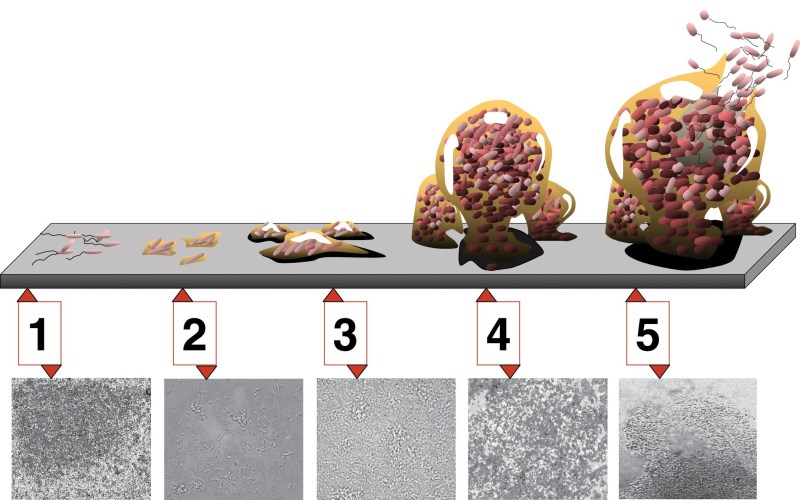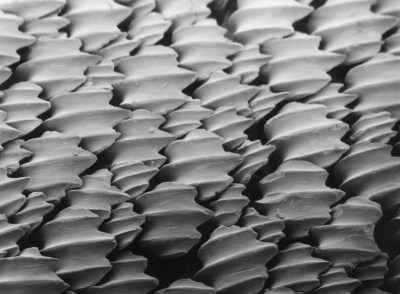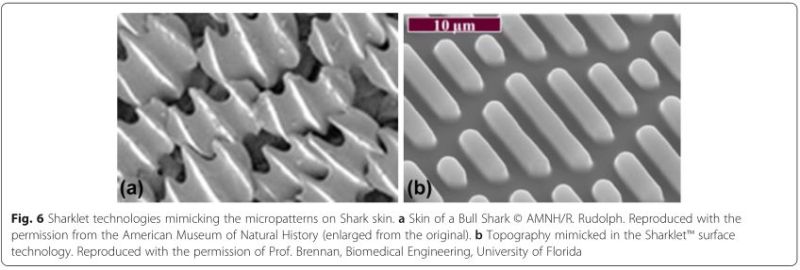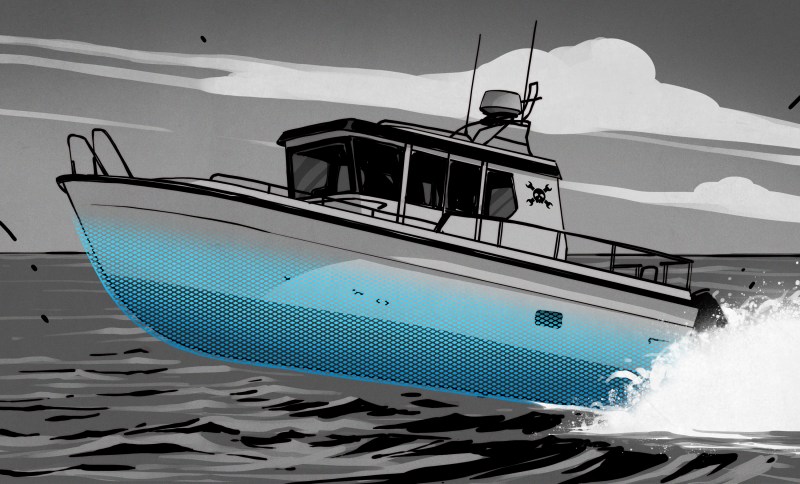You might not think that keeping a boat hull smooth in the water has anything in common with keeping a scalpel clean for surgery, but there it does: in both cases you’re trying to prevent nature — barnacles or biofilm — from growing on a surface. Science has looked to nature, and found that the micro-patterning formed by the scales of certain sharks or the leaves of lotus plants demonstrate a highly elegant way to prevent biofouling that we can copy.
In the case of marine growth attaching to and growing on a ship’s hull, the main issue is that of increased drag. This increases fuel usage and lowers overall efficiency of the vessel, requiring regular cleaning to remove this biofouling. In the context of a hospital, this layer of growth becomes even more crucial. Each year, a large number of hospital patients suffer infections, despite the use of single-use catheters and sterile packaging.
Biofilm Formation
 The formation of biofilms dates back to the earliest days of prokaryotic life, as evidenced by fossil evidence in the form of stromatolites. At its core these biofilms appear to be a defensive mechanism that prokaryotic species have initially evolved to cope with harsh environments, while allowing for the formation of flourishing prokaryotic colonies. These colonies can also enable the growth of more complex lifeforms.
The formation of biofilms dates back to the earliest days of prokaryotic life, as evidenced by fossil evidence in the form of stromatolites. At its core these biofilms appear to be a defensive mechanism that prokaryotic species have initially evolved to cope with harsh environments, while allowing for the formation of flourishing prokaryotic colonies. These colonies can also enable the growth of more complex lifeforms.
Over time, eukaryotic lifeforms would adopt a similar strategy, where after the initial attachment to a surface an extracellular matrix would be created. These biological glues and structures provide the organisms protection against desiccation and predation, as well as other potentially harmful influences.
In a marine environment, these biofilms provide multicellular lifeforms with not only a surface to attach themselves too, but also an accompanying ecosystem. In the case of barnacles, for example, the presence and type of biofilm is paramount in the selection of a specific attachment site when a young barnacle cyprid transitions to its immobile adult state. Similar patterns are observed with other marine species, the outcome of which is a thriving, if undesired, ecosystem on a ship’s hull.
Since the formation of a biofilm requires only some traces of moisture in the presence of bacteria and kin, this makes it likely that during the manufacturing or usage of medical equipment a surface becomes contaminated with a biofilm. Biofilms allow bacteria and other pathogens to survive for extended periods of time on surfaces, so lapses in hygiene form significant risk vectors.
The exact harm of such a biofilm depends on the exact bacteria and other occupants that are inside it, as well as the location of this biofilm. When MRSA bacteria find their way to an intubation or IV tube, this can provide these pathogens with a direct route into a patient’s body, forming biofilms throughout the tubing inside. Once inside the body, they will then proceed to form biofilms, as part of their protective strategies against threats like the patient’s immune system, and antibiotics.
The optimal strategy is thus to prevent these biofilms from forming in the first place, ideally by preventing the initial surface colonization .
You Shall Not Attach

An interesting aspect about evolution is that it seeks to solve many of the same problems which we seek to solve today. For marine animals, having biofilms and other growths on their skin is obviously problematic, as for them it means an increase in drag, just as it does for a ship. This means that the animal will be expending more energy when swimming, in addition to the possibility of skin and other diseases developing due to the proximity of so many bacteria.
Many marine animals rub against rocks, have symbiotic relationships with skin-cleaning fish species, or employ the same skin shedding and replacement process which we land-based species employ. The most interesting approach, however, involves micro patterning that make the initial colonization step part of forming a biofilm essentially impossible.
While scales are very common among marine and other animals, the scales of sharks and rays are unique in their microscopic patterns. In experimental testing show a distinct lack of biofilm formation. This is one of the antifouling methods described by Damodaran et al. (2016) in Biomaterials Research. It summarizes the following approaches:
- Biological molecules:
- Nitric oxide-releasing agents.
- Peptide and peptoid modified surfaces.
- Chemical modification of surfaces:
- Hydrophilic polymers.
- Immobilization of PEG.
- Zwitterionic polymers.
- Hydrophobic polymers.
- Micropatterning of surfaces:
- Lotus-effect.
- Shark-skin patterns.
In terms of what we can copy from nature, the biological molecules and surface modification approaches face high costs, limited lifespan, and limited applicability in terms of which types of bacteria they affect. Toxicity concerns face hydrophobic polymers.

That leaves micropatterning. Rather than a substance that has to be synthesized and regularly applied, these micropatterns can be etched into a surface, with the duration of the effect depending on the durability of the material the pattern was etched into. It’s also possible to use self-assembling patterns, for instance in paints with nanoparticles.

For the boat hull application, the placoid scales of sharks are particularly interesting. They seem to not only prevent bacteria from attaching, but also reduce drag by disrupting the laminar flow near the skin. It’s likely that this drag reduction was a relevant evolutionary factor in the development of these dermal denticles, and it also provides an interesting aspect regarding this type of antifouling — the micropatterns stand to reduce drag of a ship’s hull over and above a ‘clean’ hull.
Making It Scale
As with many of such antifouling techniques, the main issues are making it scale to economically feasible levels and making it last. At this point in time the lotus effect is most commonly used, as its regularly repeating pattern lends itself well to use in everything from roof tiles and fabrics to paints. The application of self-cleaning surfaces in outdoor settings is self-evident, as this prevents the build-up of algae and lichen, and also resists things like graffiti.
Shark skin-like patterning is somewhat more complicated, as it involves a more involved pattern that doesn’t lend itself as easily to self-assembly. Probably the most well-known commercialized version of this technology is found in the Sharklet material sold by Sharklet Technologies and their patented micropattern. They target mostly hospitals and similar settings for their product, and a collection of studies also show their effectiveness in the context of preventing foreign body reactions with neural implants.
One thing that ship hulls and medical tubing cannot yet do is to grow dermal denticles the way shark skin can. The shark is refreshing its skin surface continuously. It’s likely that a combination of approaches will remain necessary to fight off biofouling, although we will very likely see micropatterning being employed more commonly in the future for a cleaner and safer world that is less of a drag.
















Then there’s the “why fight inevitability” approach and find a barnacle you can breed to stay a maximum small size and plate the hull with, keeping everything else from building up on it. Then you can be all Captain Greenwash, with “Our oil tankers clean the oceans as they go” etc.
There’s some greased marble factoid rattling around in the old bone dome here. Something about lotusoid (topologically) structures, self assembling at nanoscale, was “some weird but cool crap we don’t know what to do with” called out in the breathy excitement of late 90s nanomaterials experimentation. I can’t join dots at the moment though to know where it came from and whether it’s a red herring.
A biological hull coating would be easier to construct and maintain. However, I would go with bacteria that consumes anything that would care to attach itself.
Unfortunately, this sounds like a great way to spread invasive species, especially if such barnacles were to be bred to maximize hull coverage.
True… I had thought of maybe designing them to be deficient in some element or other that could be got preferentially from the subcoating of the hull. But then you still probably have to worry about “Life, uhh, finds a way.”
“… and also resists things like graffiti.”
Bad hackaday. No dystopia for you.
It could be a pretty cool dystopia where all surfaces are spotless but otherwise the city is in ruins.
So, the microscopic cones on the Lotus are superhydrophobic
and the microscopic cones made by a laser are hydrophilic? (Fig. 5)
and…
“Placoid scales as viewed through an electron microscope. Also called dermal denticles, these are structurally homologous with vertebrate teeth”
But vertebrate teeth (such as mine) are known to have biofilms on them (plaque).
I think it’s all geometry on the small scale where surface tension and angle of contact for a droplet, get sploited by angles on the surface, and the prevention of it forming a favorable angle to attach and stick. Plus some polarity tricks.
Concering Fig. 5, you can follow the source to find that it is indeed so, and it’s the “hairs” on the Lotus cones, and the lack of them on the laser-made that make the difference between hydrophobic and hydrophilic surface.
As for homology, I think it refers to shared origin (like wings of bats and upper limbs of humans), rather than shared function.
Thanks!
Absolutely fascinating article. There was a program on PBS a while ago that talked about this. In the old days ships hulls were made of copper because nothing would stick to it. As copper got more costly they came up with copper infused paint that worked but not as well. They still paint ship hulls with copper paint. In the program they talked about copper and hospitals. The subject was antibiotic resistant bacteria and the program indicated that if hospitals installed things like copper handrails cases of mrsa and others would go down significantly. I haven’t been near a hospital in a while but the last time I was I didn’t see any copper handrails.
Unfortunately hospitals are constructed with cost as the primary factor. Anything to do with efficient workflow or patient care is purely accidental or as a direct result of the nursing staff that are left to work in the mess once the consultants and project managers have fled.
So there no way a hospital would incorporate such techniques. At least in eastern Australian states
Copper oxidizes to form a patina on the surface. The patina is comprised of various copper salts, most of which are toxic. Plus the cost is somewhat prohibitive and probably why you dont see more widespread use for handrails and such.
EPA registrations 82012-1 (96.2% Cu) and 82012-2 (91.3% Cu) keep a list of qualifying products and their suggested uses (hint: everywhere!) for things like hospital doorknobs. Group 1 was amended last year to include residual virus claims. Behr makes an approved one for public things like doctors’ offices and day cares, but it’s tempting to throw marine-grade money for marine-grade paint to the wind and paint the house with it.
here’s the amended Group 1 pdf:
https://www3.epa.gov/pesticides/chem_search/ppls/082012-00001-20210110.pdf
Brass used to be common for doorknobs and door hand plates (Copper plus Zinc). And I’ve seen brass banisters. Only to be found now in my old house and a few like it. Oh and it’s COVID-free.
(Sigh!) But some brass also has lead (Pb) in it.
Of course we should copy solutions from nature, it’s been working on them for billions of years and has never filed a single patent.
And because of a Mother Nature Patent Office doesn’t exist, it is tough to figure a lot of its secrets. We just can’t look up the Patent Number.
B^)
I for one, would like to know more on how gravity works.
Just my 2c – boat hull(underwater part) shouldn’t be too smooth(for some reason it is introducing more drag than slightly rough one).
Good old golfball effect?
So the solution is to cover the boat hull with shark skins ?
Yes, sort of… isn’t that what was presented in the article? But not sharks but a material that emulates their skin surface. It won’t happen soon enough. I’ll just have to continue having the sailboat scrubbed every other month and every two years hauled to clean and repaint the hull. Nice thought though…
And here I thought beaching your vessel every so often was good enough.
That is an excuse used by poor or lazy navigators.